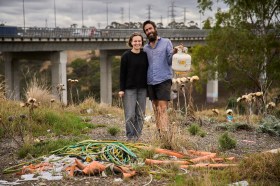First published in January 2017, Tana Canas’ article kicks off 20×20, a new series on looking back at the cultural milestones and trending topics that have shaped us. ArtsHub is celebrating its 20th anniversary in 2020, and over the next 20 weeks, we’ll take a look at how the sector has changed or stayed the same on these important issues.
Diversity is the in-vogue theme for the cultural industry, becoming an exercise in ill-thought-out, quick responses to stage diversity rather than as an opportunity to re-imagine the entire sector.
It has become painfully obvious that the sector’s increasing self-awareness and subsequent panic, has caused a scramble towards superficial diversity, rather than an opportunity to dismantle the frameworks that created the systemic exclusion to begin with. Diversity is restricted to aesthetic presentation, rather than a meaningful, committed, resourced, long-term process of shifting existing power-dynamics.
Diversity is a white word, or as Ghassan Hage describes, a ‘white concept’.
It seeks to make sense, through the white lens, of difference by creating, curating and demanding palatable definitions of ‘diversity’ but only in relation to what this means in terms of whiteness. Terms such as ‘diversity’, ‘multiculturalism’, and ‘culturally and linguistically diverse’ (CALD) only normalise whiteness as the example of what it means to be and exist in the world.
Therefore the diversity discourse within the cultural sector, has only created frames by which diversity is given ‘permission’ to exist under conditional inclusion.This is inclusion that is conditional on predefined, palatable criteria; a means to frame, describe and ultimately prescribe diversity through constructed visibilities.
Just because we exist in a space, doesn’t mean we’ve had autonomy in the process by which the existence has occurred. It is not about ‘giving a voice’, we already have one. It has been systematically silenced. What we are talking about is power and self-determination.
Diversity is not about assigning spaces for designated self-expression in which we speak within spaces designed for us – diversity in cultural leadership as challenging the very terms of engagement and enunciation.
Question the terms of engagement
The arts industry relies heavily on its reputation and expects engagement, upon and within the terms already set. These terms, protocols and thus curations of engagement remain within the terms of enunciation that reproduce enunciator – enunciated dynamics. In so doing, it thus fails to shift power-dynamics and roles in the arts.
The diversity discourse, when it sits within the same terms of enunciation, is ultimately superficial as it lacks collective, meaningful, decision-making as well as a vision for core industry change.
The industry needs to critically check its intention positionality, and ultimately, its ego. Asking what the aesthetic and epistemic assumptions are carries? It needs to be willing to be vulnerable, take risks, radically listen and surrender the ‘need for immediate affirmation of successful’, says academic B. Hooks.
Read: Beyond the racist hyphen (2016)
For the sector to rely solely on its reputation is in this case – to rely on colonial definitions of institutionalised culture – the very same ones that have historically and not only defined but systematically excluded ‘othered’ voices.
Participation vs presentation
It must also note that there are multiple manifestations as to ways in which participation occurs, understanding that participation can just as easily be token as progressive, as Arnstiens Ladder of Participation suggests.
It is also not enough to just pay participants in a project developed from top-down. Ask instead what are the pathways for core involvement? Key decision-making power and self-determination? How are the terms reproducing representation rather than shifting/challenging?
Participation in the form of presentation is not enough, we need to be part of the creation of our own representations, through diversity in cultural leadership. It is not about the spaces being created for visibility but how they are created.
Don’t look for authenticity, seek multiplicity
The sector needs to abandon its quest for authenticity and instead seek multiplicity. Authenticity is determined, verified and labelled by the dominant narrative in relation to periphery narratives. When tied to ideas of staging ‘authentic voices’ the arts restricts, places demands on form and content as well as systematically silences the multiplicity of truths. It is an exercise of institutional and national power from the entitled to do so (Hage, 2000). Multiplicity, as opposed to authenticity, defies constructs that are palpable and easily consumable to the dominant narrative.
Build community, not audiences
The recent discourse on diversity comes at a very deliberate moment and in a rush to look progressive the industry is looking for a superficial-fix.
It does so by identifying artists who have ‘made it’ (without acknowledging their ongoing social struggles to do so) and throwing them onto the stage in a self-appeasing manner. This often comes in the form of Ambassador Programs, the industry can say it is doing something but in reality it has no clue about how to develop, nurture, support nor fiercely defend artists.
The industry wants to ‘highlight voices’ without the responsibility of meaningly supporting them.
Tana Canas
Sarah Ahmed, in ‘on being included: racism and diversity in institutional life’ argues that to recognise diversity requires a time, energy and labour to be given to diversity. Recognising thus the material as well as symbolic: how time, energy and labour are directed within institutions (p. 29) rather than it be left to ‘chance’. As with ambassadorships however, appointments of a sole diversity officer or diversity ambassador can actually be an indication of the absence of a wider support for diversity throughout the entire institution.
The sector thus needs to trust and be prepared to take risks. To do so, the arts must apply community-engagement methodologies, not with the aim of building audiences but building and strengthening community. It is not working for community, and sometimes not even with but as community, exemplifying a praxis of ‘nothing about us, without us.’
Process and production, not just prograMming
Self-determination in the arts can only occur through, ‘a real control of all the means of communal self-definition in time and space.’ (Ngugi, 1986). In order for this to occur the arts must democratise the means of theatrical production. This means looking at the entire industry, as a microcosm of power dynamics. Democratising the means of theatrical production provides an avenue for reframing the very terms of engagement that, regardless of intention, often reproduces the same enunciator-enunciated dynamics.
In Space invaders: race, gender and bodies out of place (2004), Nirmal Puwar argues that diversity has come to overwhelming mean the inclusion of people who look different. The very idea that diversity is about those who look different shows us how it can keep whiteness in place. Thus it becomes about generating the ‘right image’ or in other words changing the perceptions of whiteness rather than changing the whiteness of organisation.
Quotas are not enough
The considerations regarding quotas must come with the understanding these are not enough. If we are talking about systemic exclusion then we must look at the entire institution, organisation, and the sector. Our consideration needs to go beyond the perceived ‘entry point’ as the sole problem.
The ‘entry point’ is only a minute aspect of the bigger problem. The sector must support this further with a more critical and holistic, socio-spatial and political understanding of its very existence. Quotas do nothing if you are just introducing and expecting us to exist within the same colonial structural terms of enunciation. You might let a few of us in through quotas but no further support throughout an entirely white institution.
Read: On being an ally for diversity (2019)
First Nations, not just white definitions of ‘diversity’. In colonial settler contexts, terms often remain defined and aligned with colonial history and processes and contemporary manifestations within institutes.
The diversity discourse has often been used at the expense of First Nation representation and sovereignty. White definition of ‘diversity’ applied to reproduce white Australia ideology, bureaucracy and thus institutional whiteness in the arts. In so doing, diversity discourse becomes another extension of ongoing colonial violence.
You can’t talk about ‘diversity’ and undoing institutional whiteness without real, meaningful solidarity with First Nation Sovereignty and self-determined processes in arts, culture, community engaged practices and beyond.
Conclusion
Without rethinking terms we run the risk of already ‘othered’ voices becoming further tokenised through the diversity discourse, rather than the lack thereof.
We create disposable voices, restricted to exist within the same power structure that excluded them in the first place. It is not good enough to seek being included in the same discursive, epistemic and systemic architectures, as mere additions, but it has become urgent and vital to (re)think, (re)conceptualise in order to critically (re)imagine the entire sector.
Cultural diversity in leadership is a step towards changing the terms of the conversation, and who gets to enunciate whom?
It shifts from responding to questions to asking questions and allows for us to do the inviting rather than just getting invited. This is a conceptual shift from working for community, and not even with, but as community.
A version of this article was first given as part of the International Society for Performing Arts Congress, ‘Reimagining’ May 30-June 4, 2016 at the Arts Centre Melbourne as part of a talk and panel on Diversity in Cultural Leadership.





